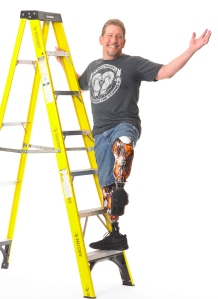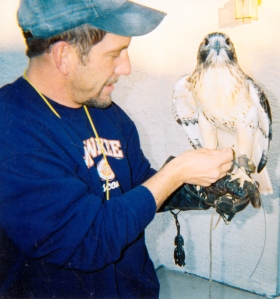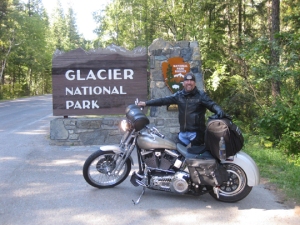Archive
Meet the Unstoppable Greg Sutter

Greg today – climbing ladders was part of his “Prosthetic Boot Camp” therapy at the Rehabilitation Institute of Nevada at Rose de Lima.
Born and raised in Milwaukee, Wisconsin, Greg Sutter moved to Las Vegas in early 2002. A firefighter from 1989 to 1995, he took a deferred retirement to run a landscaping and lawn service business he had started while still fighting fires. Then in 1996, Greg joined FedEx Express® (FedEx). He worked mornings six days a week at his landscaping business then afternoons five days a week at FedEx. He ultimately transferred to Las Vegas with FedEx.
“I fell in love with Las Vegas back in the early ‘80s,” says Greg. “I love its openness, climate, and the nearby mountains.” While living in southern Nevada, he has traveled extensively, accumulating about 85,000 miles touring the western and mid-western parts of the country on his 2000 Harley Davidson Springer Softail. “I’ve visited nearly every national park in the Western U.S.,” says Greg.
But Greg’s days of Harley riding came to an abrupt halt in September 2014 shortly after returning from a nine-day solo ride to Glacier National Park. “I was in relatively good health for a 51-year-old guy,” says Greg. “I took a low dose of blood pressure medicine but had stopped taking it for 6-7 weeks.” After suffering symptoms he thought might indicate heart trouble, he went immediately to his primary care physician who did EKGs and blood tests. The test results indicated an immediate need for him to go to the emergency room because his troponin levels were sky high. (Troponin is a combination of three proteins that are integral to cardiac muscle contraction).
“I had six people surrounding me within three minutes of arriving at the Rose de Lima emergency room,” says Greg. “They did a variety of tests, but everything kept coming back normal.” Even the cardio cath showed that Greg’s coronary arteries did not have any calcification or plaque buildup. Ultimately, a 3D arterial CT scan was done, which showed that his right coronary artery had grown between his pulmonary artery and his aorta. He was diagnosed with a coronary artery anomaly, a condition commonly heard of in elite athletes who die suddenly during games or practices.
Dr. Robert Wiencek, cardiothoracic surgeon “extraordinaire” (per Greg) with St. Rose|Stanford Clinics, performed coronary bypass surgery on Greg, which was a complete success, and he was up and walking less than 24 hours later.
Five days later, Greg’s condition suddenly changed. His hands and feet became swollen and discolored, so he was placed into an induced coma and ventilated for six days while doctors ran tests. Greg was diagnosed with Disseminating Intravascular Coagulation (DIC), which has an over 50 percent mortality rate. DIC is the body’s response to massive hemorrhage, but Greg’s body was not, in fact, hemorrhaging. Coagulated blood was being pushed into his extremities, so physicians had to draw off that blood and replace it with fresh blood, along with blood thinners, to prevent Greg from dying.
After recuperating at the San Martín Campus’ ICU for 10 days then spending an additional 13 days there, he was transferred to the Rehabilitation Institute of Henderson at the Rose de Lima Campus where he rebuilt muscle and regained his strength. Greg was discharged with gangrene in two of his fingers and both of his feet, which were necrotic (the tissue had died).
Greg and his doctors decided together that amputation – below the knee on both legs and removal of both fingers – was the best course of action. But surgery could not be scheduled for nearly two months because they had to wait for the gangrene to stabilize (a line of demarcation would form to show the parts of his hands and feet that were alive and those that were not). He recovered at home with daily wound care, physical therapy, and nursing care.

Greg is a licensed falconer and was “the custodian and grateful observer” of Lucidity, a 15-year-old female red-tailed hawk, until she passed away in June 2015.
Greg’s amputations took place at Rose de Lima. He spent 24 hours in the intermediate care unit followed by 21 days as an amputee patient in the Rehabilitation Institute where therapists helped him get ready to go home in a wheelchair. Greg healed at home for eight weeks then was readmitted to the Rehabilitation Institute for the third time for intensive prosthetic therapy and training – or what he jokingly refers to as Prosthetic Boot Camp.
“The rehab team custom fit a therapy program designed specifically for me,” he says. “Knowing that I’m a FedEx driver, the team had me climbing 8 foot step ladders and doing stairs from the first to the fourth floor and back nonstop. Initially, I had to use my upper body strength, then I learned to shift the emphasis to my lower body by using my new prosthetics.”
Greg’s favorite form of physical therapy was what is now called the “Sutter Hill Challenge” because he challenged his physical therapists to walk the hill with him. During his first stay, Greg had to stop 4-5 times before making it to the top. On his second visit, he conquered the hill while in a wheelchair. At one point, his therapist, Stephanie, said, “let’s go do the hill.” Greg’s response was “If I do it, you do it,” and she said, “You’re on. I accept your challenge.” That wheelchair challenge was closely followed by another with his therapist, Kim, who also succeeded the first time. The therapists still use the Sutter Hill Challenge with their patients.
Throughout his treatment, Greg has stayed positive. He feels his journey unfolded because God was preparing him for what was happening. “I had time to prepare emotionally because I was kept fully informed about what was coming by my medical teams,” he says. “I was at peace with everything until the morning before my amputations. I lay in bed very anxious and began to pray, and I was overcome with a calm, peaceful message that everything would be okay. I haven’t had an anxious moment since.”
“Greg has an attitude of empowerment that is contagious,” says Dr. Tony Chin, physiatrist, and Medical Director of the Rehabilitation Institute. “He participated at a level that was encouraging and inspiring to both the patients and the staff … our nurses and therapists would get daily hugs and ‘doses of Greg’ before starting their shifts. God’s light literally seemed to shine through him.”
Greg now has a customized set of prosthetics that he is becoming more comfortable with. “They reflect my ‘fiery’ personality,” he says. “If I have to wear them, I figure I might as well have some fun with it.” He’s even been to Christian music festivals where the musicians have signed his prosthetics, and “they spur some interesting conversations almost everywhere I go,” he laughs.
And his Harley? Greg met his goal of being back on his bike with the wind in his face in late August. In fact, Greg went on his first overnight ride – he and his cousin rode to the North Rim in mid-September – on the one year anniversary of his experience starting.
If you would like to communicate with Greg, e-mail him at reach@dignityhealth.org.



